
Steamboat Models, page 2
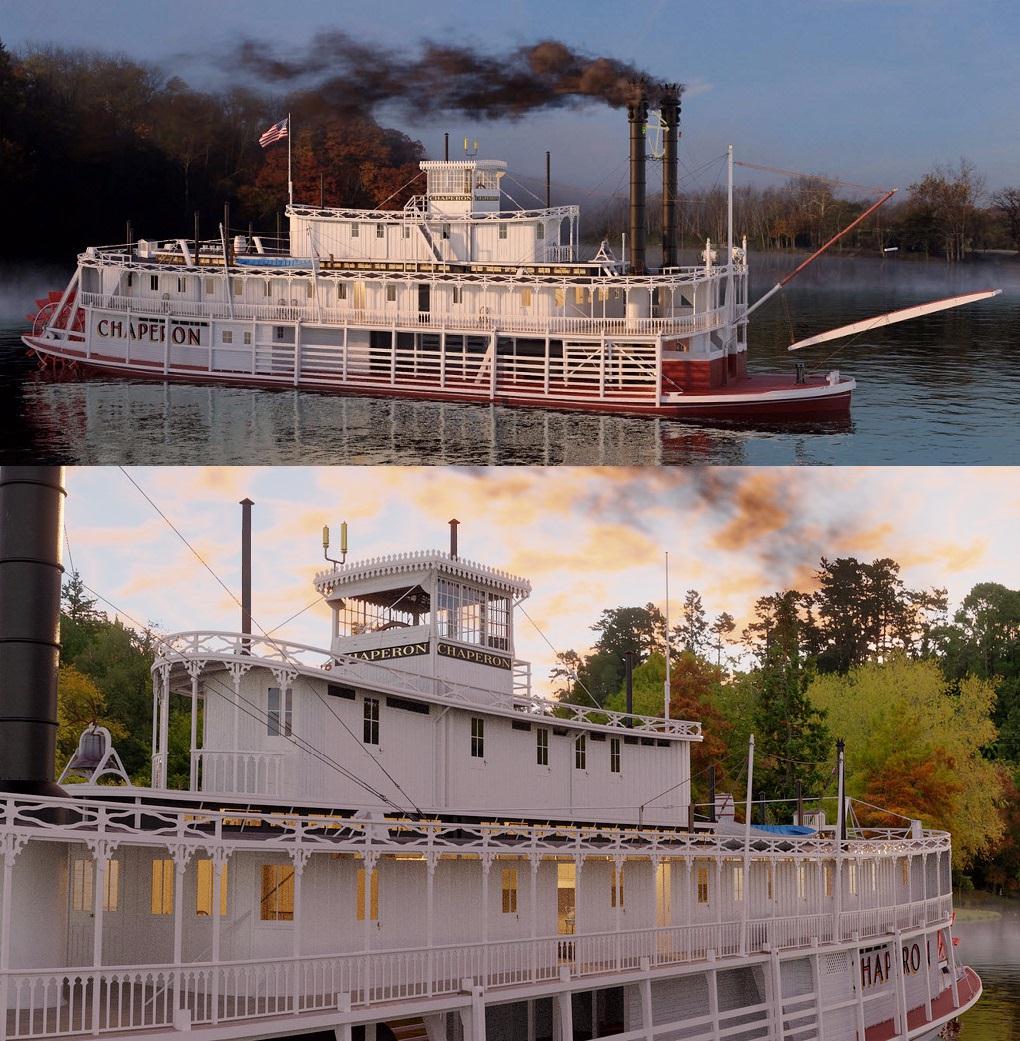
Screen captures from "flickr" of 2 beautiful composites by "jmiba" of the CHAPERON on the river.
Fryant believes this is a "virtual" CHAPERON model. Jens Mittelbach sent a link for more information about the Virtual chaperon project: jensmittelbach.de. You can use anaglyph goggles in order to watch this in 3D. There is also a resource page with some downloads and a bibliography of literature that I used to virtually reconstruct the Chaperon: jensmittelbach.de
These two images were apparently accomplished using photos of a completed kit of the CHAPERON, (the same one that John Fryant built and upgraded details for the pilot house to correct inaccuracies and other model builders seem to have followed the improvements that John described in the REFLECTOR.
The flickr contributor "jmiba" also created a 360 degree interior view of the cabin of the CHAPERON from stem to stern that appears to have been created digitally. It can be viewed at the the third link below.
JOHN FRYANT'S RESPONSE TO "jmiba"'s CHAPERON on flickr:
My, my - - hadn't ever seen these. I think what we have here is a total digital creation and a darn good one. I can tell that the creator used the kit model for some of his research. The sides of the cabin skylights are black and that's what the kit instructions called for. (Should be white.) Also, the spacing of some of the boiler deck stanchions and trim correspond to the kit instructions. There are no known photos of Chaperon's interior but the artist has done a great job of creating a typical small steamboat cabin. Also he/she has shown the hull painted red with a white stripe. One of the Murphy Library photos shows her with a dark hull and light stripe.
While the virtual model is perfectly done it appears too clean. There's no cargo aboard, nor ropes laying on the deck and no mud or dirt anywhere. No crew or passengers either.
By: jmiba
Some rights reserved
finished (starboard profile)
Riverboat Chaperon (1904-1917)
flickr.com
September 19, 2017
pilot house Chaperon
flickr.com
June 25, 2017
cabin 360 The steamer Chaperon's cabin
flickr.com
April 2, 2017
A slide show / no sound / with two files shoing phpases of Jens Mittelbach's digital recreation of the Chaperon!
speakerdeck.com
Mittelbach's previews of his computer rendering of the J.M. White. He has 4 previews online and of those 4, this one impressed me the most. HIs starboard 3/4 profile of the steamer does not yet include the pilot house & Texas but should be soon.
To see what Jens has accomplished so far on this project go to this link: jensmittelbach.de 3D Model of the J.M. White
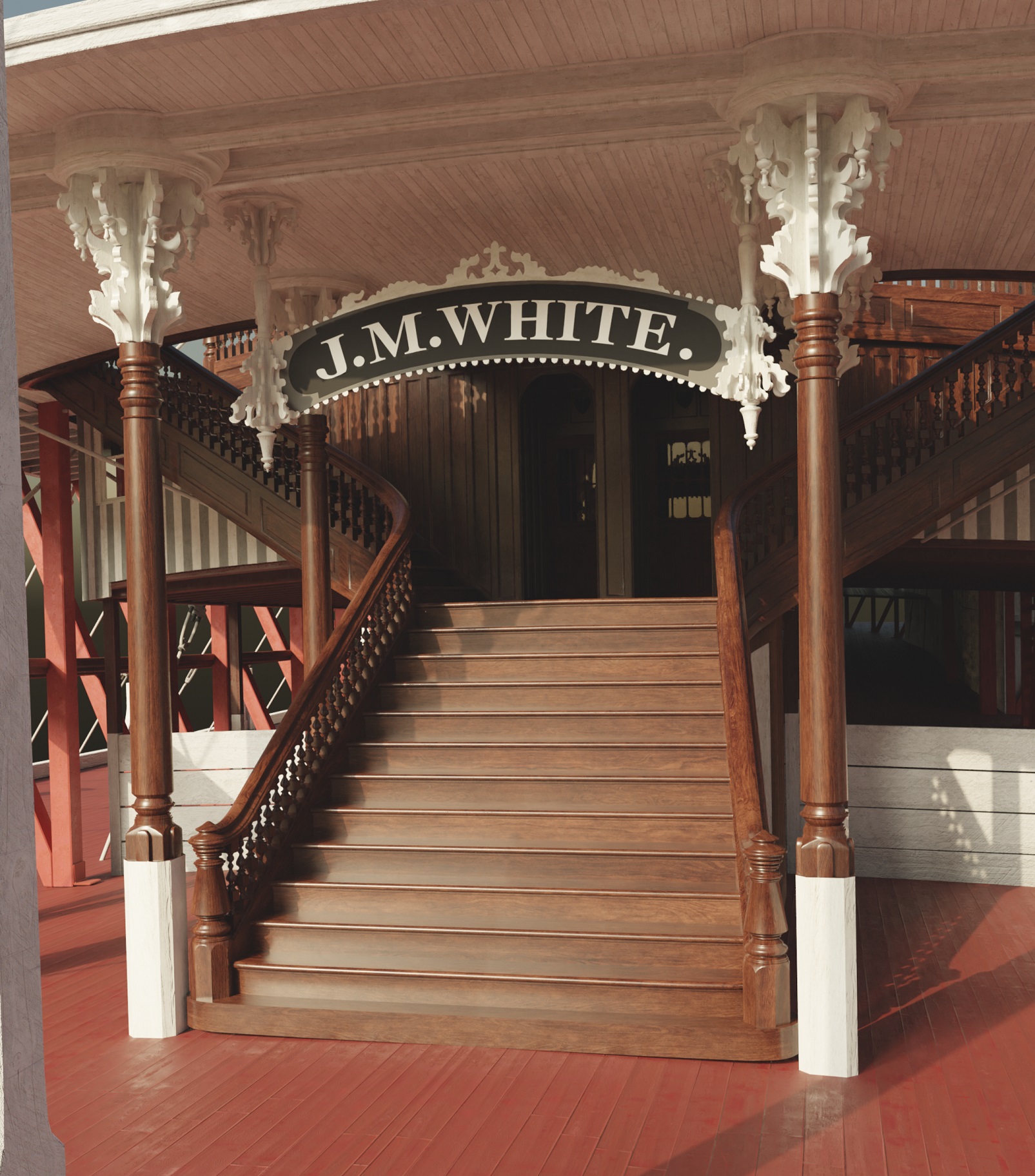
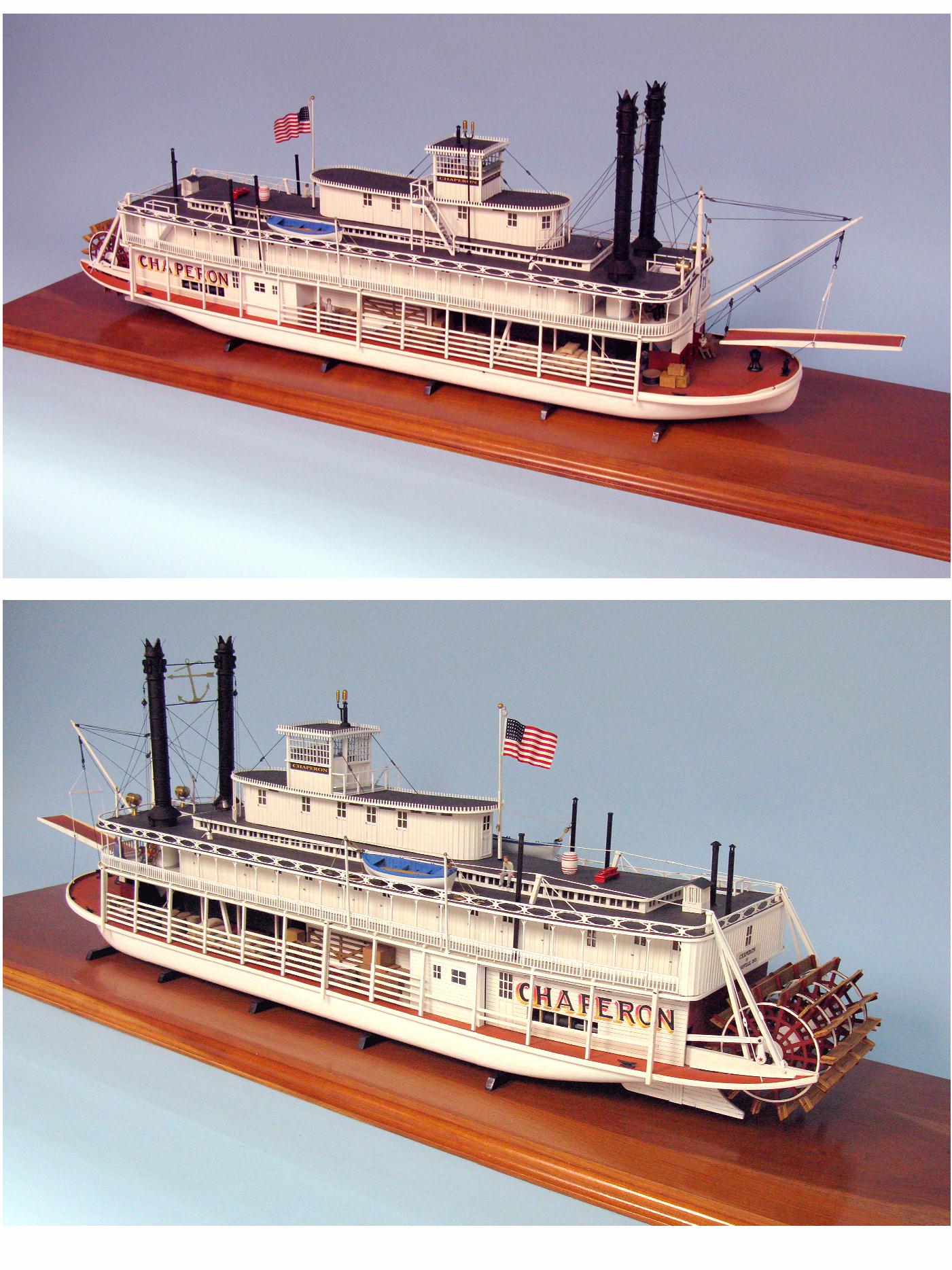
The ModelExpo kit of the CHAPERON which John Fryant assembled for me, correcting the historical errors in the kit as he went along. Following is a transcript of his article about building the model.
S & D Reflector
December 2011
Small Stacks
A Closer Look at the CHAPERON - Part Three
Pages 32 & 33
by John Fryant
In September's column, mention was made of inaccuracies in the CHAPERON ModelExpo kit. Having recently completed one, there are some major shortcomings which I discovered.
The most obvious is the pilothouse which has windows all around and no interior detail, despite John Breynaert's plans (on which the model was based) that clearly show the typical pilothouse open front with breast board, visor, and interior details of pilotwheel, stove, lazy bench, etc. Also, the laser cut one-piece windows are a bit heavy looking, whereas there were actually three sliding windows on each side and two in back, in typical riverboat fashion. In my opinion, the windows would have been better done in photo-etched brass like the railings.
The laser cut sternwheel spoke units have omitted the outer ring of braces and are too thick. They should have been cut from 1/16" thick plywood instead of the 1/8" basswood supplied. The kit- supplied sternwheel spoke unit appears to the left in the previous photo, with a corrected version to the right. The cranks on the paddlewheel shaft are twice as long as they should be. As the CHAPERON had four foot-stroke engines, the cranks should be only 1/2 inch long center to center in 1/48th scale. The roof bell should be about twice the size of the one provided.
While the photo etched brass railings are very well done, they need cap and bottom rails. On my model I used tiny plastic channel for the top rail and plastic strips for the bottom. The plastic channel is available from Plastruct at their website (www.plastruct.com) and is product 090535. The finished railing appears in the photo below. The photo-etched brass turnbuckles look strange, as they are two-dimensional. There are many sizes of turnbuckles available from model railroad suppliers as metal or plastic castings which would have looked more realistic. The fittings that go atop the sampson posts for attachment of the hog chains are oversize. They have been cleverly designed, again in photo-etched brass, to be folded into their proper shapes, but they look too large. I omitted these entirely and ran the hog chain rods over the tops of the posts. The castings supplied for the whistles are very poorly done, having no recognizable shape. I scratch-built two whistles from brass rod and wire.
The kit box photo shows cabin doors painted red, whereas they were actually painted white, in typical steamboat fashion. The main deck is shown in natural wood, although it was probably painted with red lead or some shade of red, at least on the head of the boat and on the fantails. Some packets were done this way, with the mid portion of the deck left unpainted. The windowed sides of the skylight roof are shown painted black, as is the rub strake around the main deck. Both should be white.
There are other minor things that could be corrected, but they aren't as obvious, except to the die-hard steamboat researcher. Overall this is a nice kit that goes together almost flawlessly. Unfortunately, the above mentioned items weren't correctly done and I hope perhaps they can be corrected in future issues of the kit.
Link to the S&D Reflector - click here. # # #
Below: Proving that kittens like steamboat models too, here is Abby the kitten plotting how to get at the rigging of the CHAPERON. (Case is temporary from another model to keep boat safe until a case built to fit the cheery wood base is made.)
Lower photo: Kitten Abby gives cat blessings to a model of the Robert E. Lee.
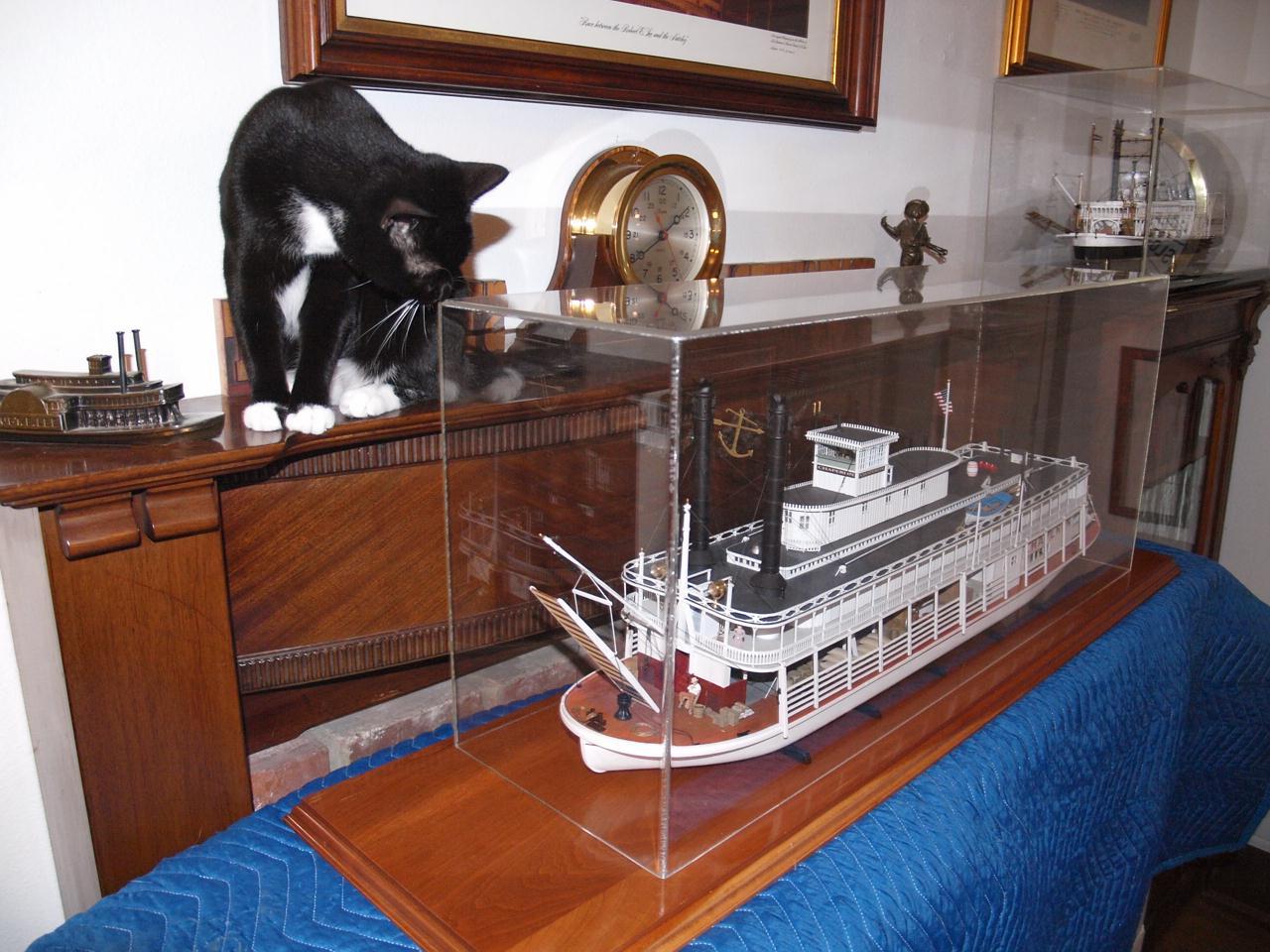
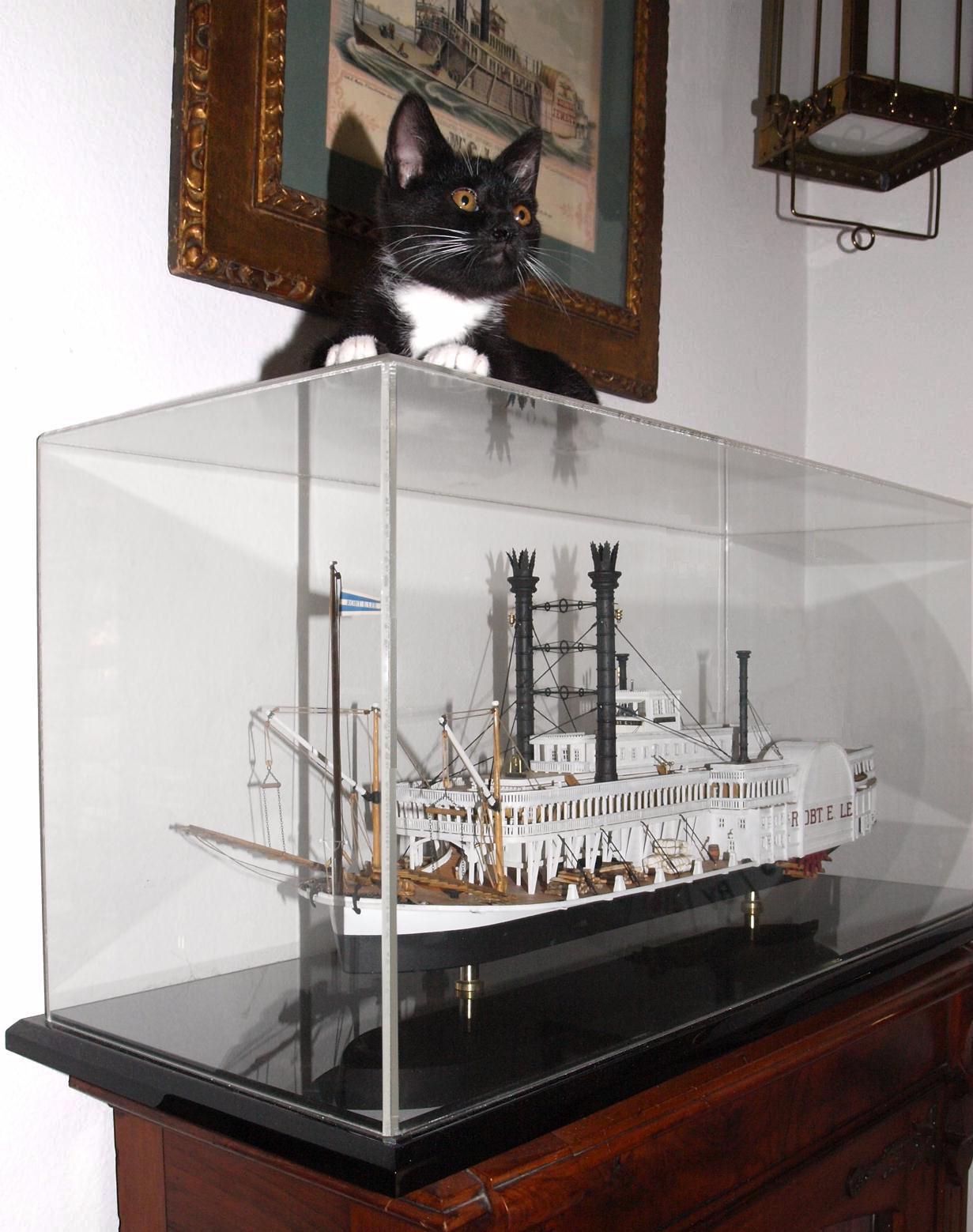
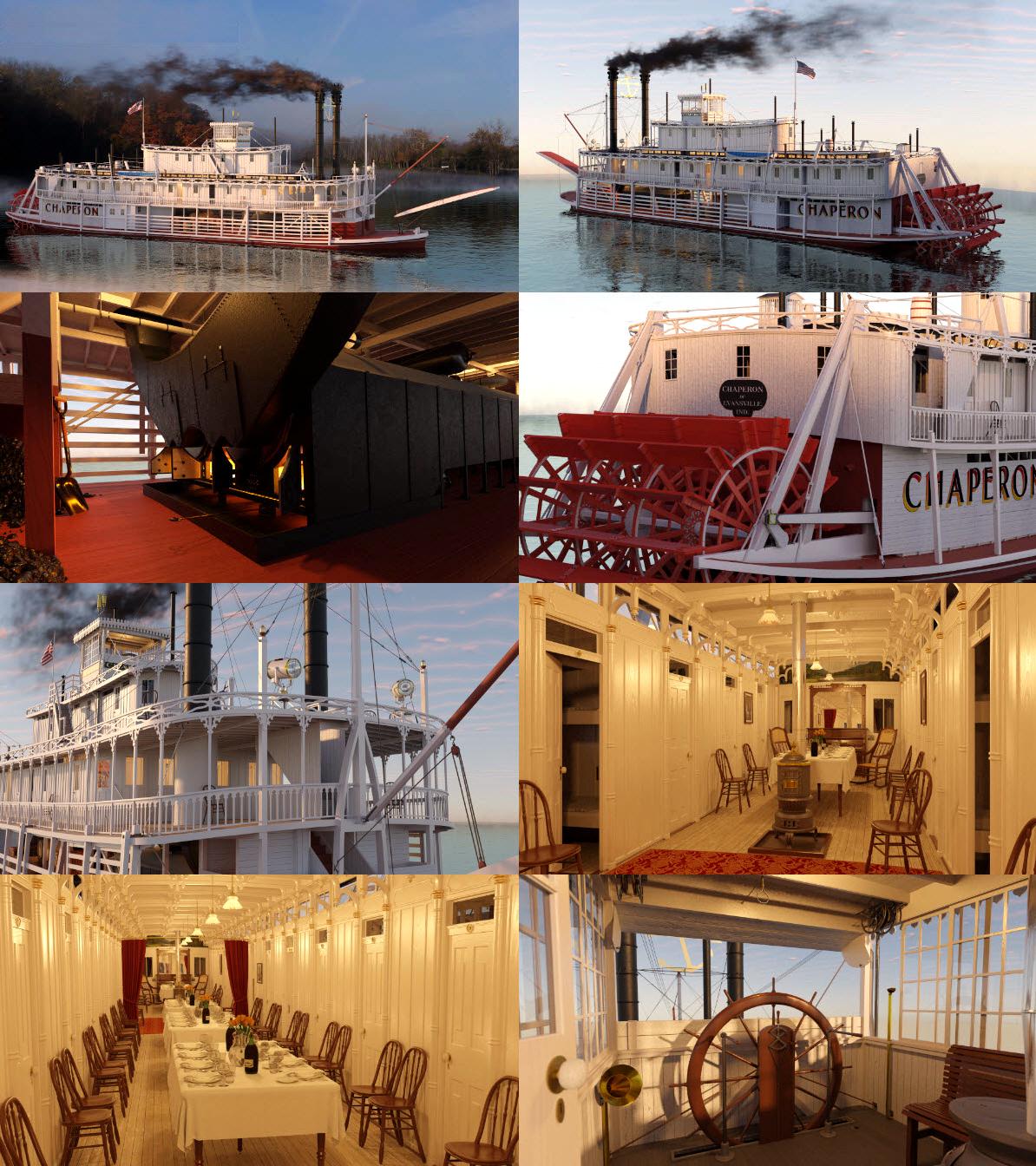
CHAPERON virtual computer realized Steamboat! Link to images
Here are 8 beautiful images of Jens Mittlebach's brilliant re-creation of the steamboat CHAPERON that he achieved with the 3D modeling software BLENDER. In his bibliography Jens credited our collection along with 49 other references. Below that is John Fryant's thank you for bringing Jens' work to his attention.
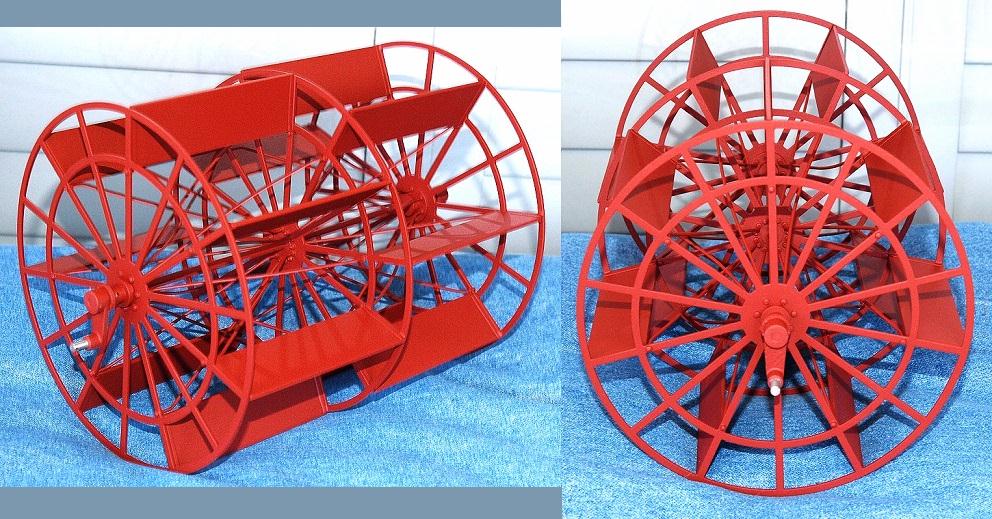
Australian Sternwheel Scale Model
Scale model metal sternwheel bought from a dealer in Australia. The style of the wheel's construction appears to be similar to the Siberian sternwheeler that is at the top of the page in our photospostcards1.
The "paddles/buckets" were not included with the wheel, they had probably been made of wood. Utility Specialized Metals in Sun Valley made replacements for me out of sheet metal with perfect precision.
Dimensions of the wheel:
8.25 inches in diameter
9.35 inches overall width
There are slots for fourteen (14) paddles/buckets that each measure:
.10 inches thick
1.35 inches wide
4.55 inches long
Andrews Powder Coating in Chatsworth added the durable coat of brick red to the wheel and paddles, taking extra care so it will be capable of resisting water in case it is ever incorporated into an R.C. model. I enhanced/saturated the color in these photos of the completed wheel that I picked up today 22 March, 2019 from Scott Andrews and Chris Doll.
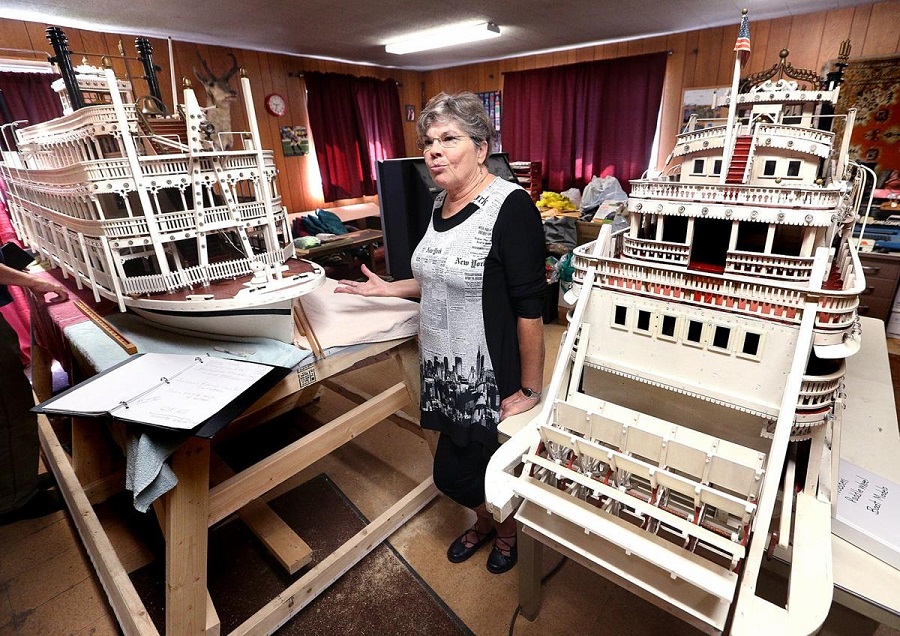
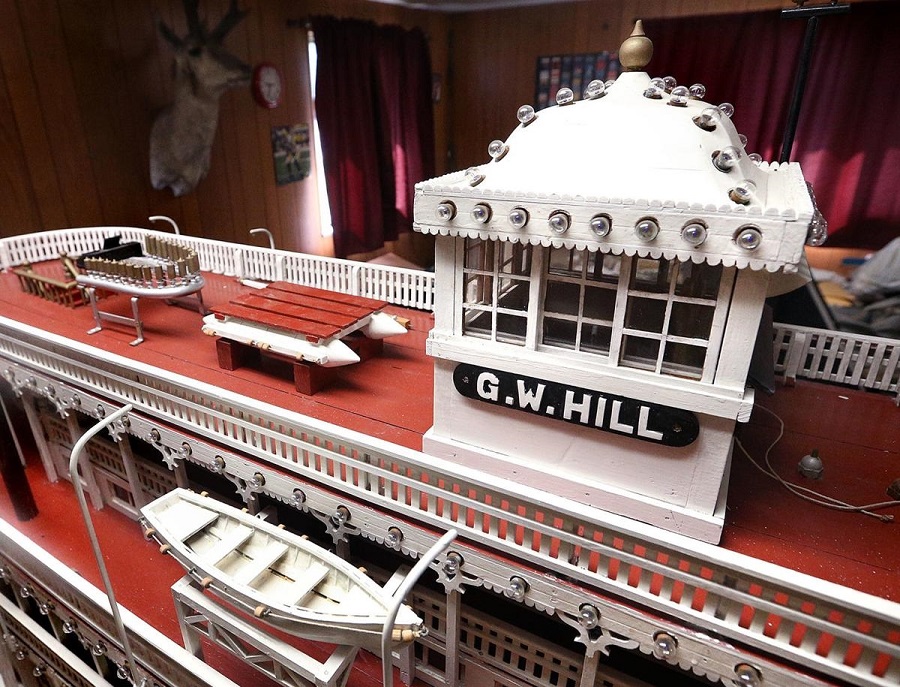
Steamboat Models of the G.W. HILL land the WASHINGTON made by Melvin "Mac" Frederickson
Photos by Peter Thomson of Models of G.W. HILL left, WASHINGTON right made by Melvin "Mac" Frederickson. Cyndy Schaper stands between them. Rescued steamboat models are stunning throwback to river's heyday
by Mike Tighe
La Crosse Tribune
Sept 8, 2018
https://lacrossetribune.com/news/local/rescued-steamboat-models-are-stunning-throwback-to-river-s-heyday/article_d2b5c58b-b3a7-5580-a0f1-71a3a6c324e5.html
Cyndy Schaper is up a creek with a paddle. Wheeler. A paddle wheeler.
Schaper is looking for a place to moor a 10-foot, hand-crafted paddle wheeler, which features details so accurate and intricate that it looks as if it could ply the Mississippi River with teensy-tiny passengers.
Its original, the full-size G.W. Hill, also had three decks, as well as a Texas deck, with a pilot house topping it all off and smoke curling from its smokestacks as the steam-powered paddle wheeler transported people and products up and down the river.
The model of the Hill, which is 3 feet tall and 2 feet wide, is more than 60 years old, the handiwork of Melvin "Mac" Frederickson.
A jack of many trades, Frederickson whittled and sawed and sanded the parts for the boats when he wasn't repairing upholstery and truck details at Robinson Transfer in La Crosse.
Rescued from blackening neglect
The G.W. Hill, along with another historic paddle wheeler, the Sidney—later named the Washington and so named on the model —
had sat in a Robinson office, neglected, for a couple of decades until Schaper got a hankering to restore them about three years ago.
Both are miniature versions of steamboats that traveled the Mississippi River in the early part of the 20th century.
"I saw them, and I just loved them, but they were just bad. They were black," said Schaper, who happened on the project by virtue of her friendship with Paul Robinson, who now has custody of the boats as a son of the late Ellsworth and Eleanor Robinson, who owned the freight carrier.
"I cleaned them off and on for three years," she said, also crediting others with helping with the restoration and education—especially Bob Taunt, a writer, photographer and local historian who also is a popular speaker because of his knowledge of days gone by.
Schaper's cleaning tools included cotton balls and swabs, dental floss and ear cleaners, and friends who would drop by on occasion to swab the decks and clean the minute filigree on the boats.
The 69-year-old Schaper came by her love of riverboats naturally, explaining, "I grew up near Trempealeau and ran down to the river to see the Delta Queen, and I rode the Delta Queen once."
Schaper, a teacher with a continuing interest in educating people, believes the models are ideal teaching tools about river lore and the Coulee Region's history as a hub of river transportation. Schaper has been fishing high and low for a public place or business that would be willing to display the boats, and she finally landed a spot for the Washington.
That model, which is 8 feet from bow to stern, 3 feet from the hull to the top of the smokestacks, and about 21 inches from port to starboard, will be anchored inside the south entrance of the La Crosse Public Library at 800 Main St., said Barry McKnight, the library's program coordinator. It also will feature a digital display of steamboats and river history, McKnight said.
That fits Schaper's overarching goals of letting people examine boats from the river's heyday and teaching the role the river played in settling the area, she said. "Both steamboats were based in La Crosse, principally for tour excursions," said Taunt, a longtime member of the La Crosse County Historical Society and its former president.
Neither has sleeping accommodations. The Washington's decks are open to the air, with areas for cargo and animals as well as human passengers. The Hill has windows but doesn't appear to have cabins, because there would have been more doors, Taunt said.
La Crosse holds record for landings
"Nobody remembers that La Crosse was the hub of steamboats," a pivotal year for river traffic, said Taunt, who also answers to Schaper's longer description of him as "kind of the Steamboat Guy" at the Riverside Museum and his own nickname as a "technical consultant" at the museum and to her.
"La Crosse has the permanent record of the most steamboat landings" in 1857, the peak year for such traffic, he said.
La Crosse recorded 1,469 landings that year, beating Winona's 1,300 and leaving St. Paul's 711 landings far in its wake, according to the Steamboat Guy. "It was called the hub because it was between Dubuque and St. Paul. Later, it was called the Gateway City," said Taunt, whose other roles in life have included being La Crosse County's personnel director and portraying George Byron Merrick, a Mark Twain contemporary who was a riverboat pilot in history pageants.
"There were a lot of guys around on paddle boats," he said. "The guys on the Ohio River wouldn't go on the Mississippi because of its 4 mph current" —apparently akin to warp speed back in the day.
After the Civil War and the development of the railroad, the iron horse nibbled away at river traffic as the main way to transport goods, Taunt said.
Taunt marveled at the size and details on the boats, both of which have hundreds of light bulbs and a couple of spotlights that Frederickson wired to glow. An electrician advised against trying to light them now because of possible wire deterioration, Schaper said.
The boats have virtually all of the bells and whistles that life-size craft had, including thousands of spindles on the railings that must have taken the patience of a saint, working pulleys threaded with rope-like string and lifeboats looking real enough to have been lifesavers on the Titanic.
Riverboats didn't need many lifeboats, Taunt said, because pilots could just beach them ashore to avoid sinking if problems arose.
Another facet that must have been painstaking for Frederickson is that windows on both boats are made from glass, with small pieces of wood delineating sections. Even the wear and tear on the boats, with scuffed railings here and there and smudges once in a while, appear as natural as if the weather and passengers had created such flaws.
Asked the value of the boats, Robinson said he never was able to establish that, saying the answer he often received was that they are worth whatever someone would pay—with the implication that the price could be cheap to one buyer one day and expensive to a real steamboat buff who might come by another day.
Even insurers were not comfortable evaluating the models, so they wouldn't sell policies, he said.
In Schaper's eyes, the boats are priceless, but she doesn't want people to have to pay to see them.
"The whole point is to have them in a store (or other location) where people could look at them for free, because they are beautiful boats," she said.
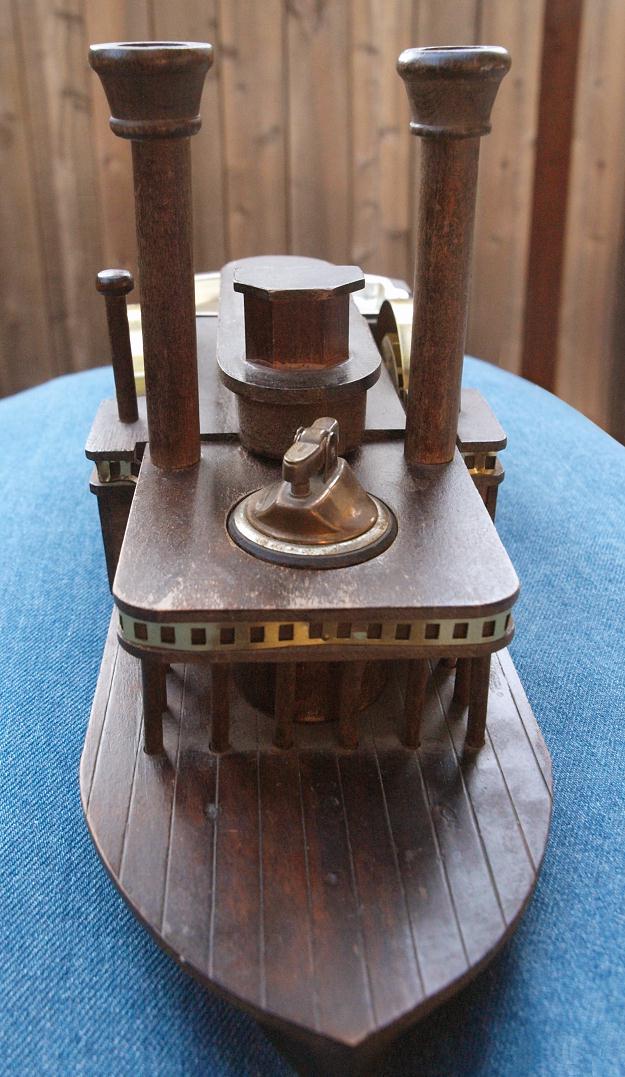
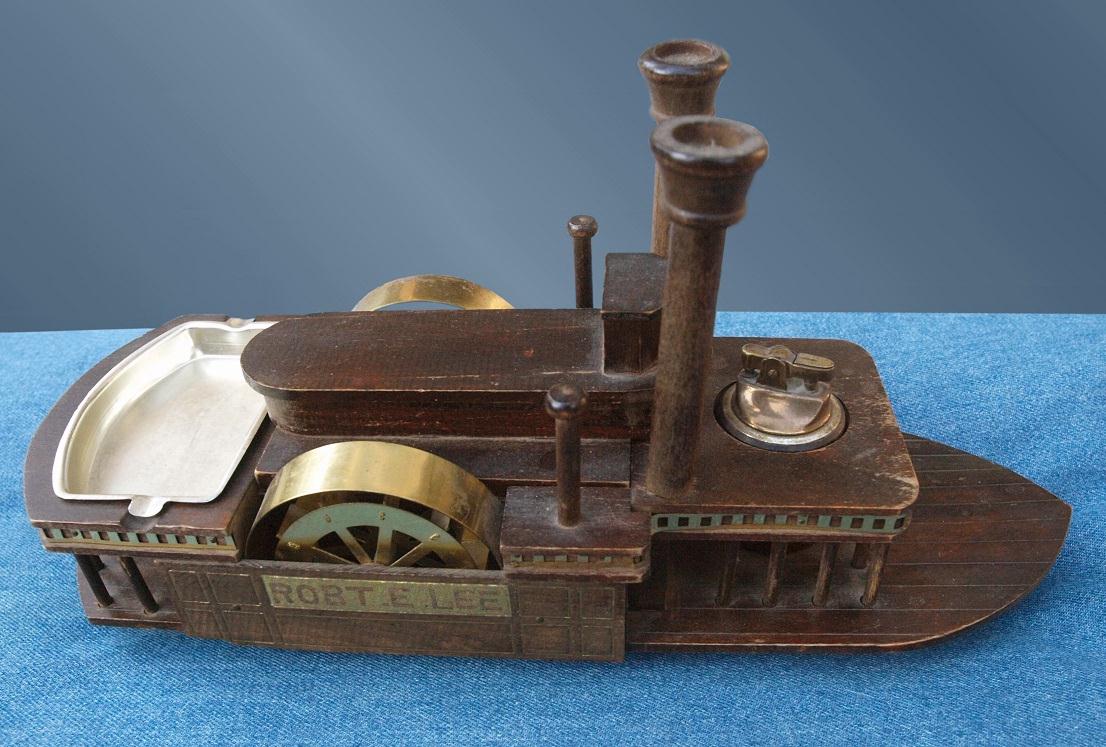
Smoking Station Steamboat
Purchased from ETSY dealer "OldeTownCurioShop'
Smoking Station Steamboat - likely a one of a kind item!
Vintage from the 1960s
wood, metal
HAND MADE Vintage Smoking station with lighter (front), ashtray (rear) and cigarette holder (center).
Built to resemble the famous, historical, late 1800's steamboat ROB'T E. LEE
Made of hard wood - possibly ash or maple.
Stained in a dark tone.
Finish overall very good with some wear.
Overall in very nice shape.
A unique tobacciana collectible
14.5" long
5.0" wide
7.5" high (to top of stacks)
2 lbs 2 oz
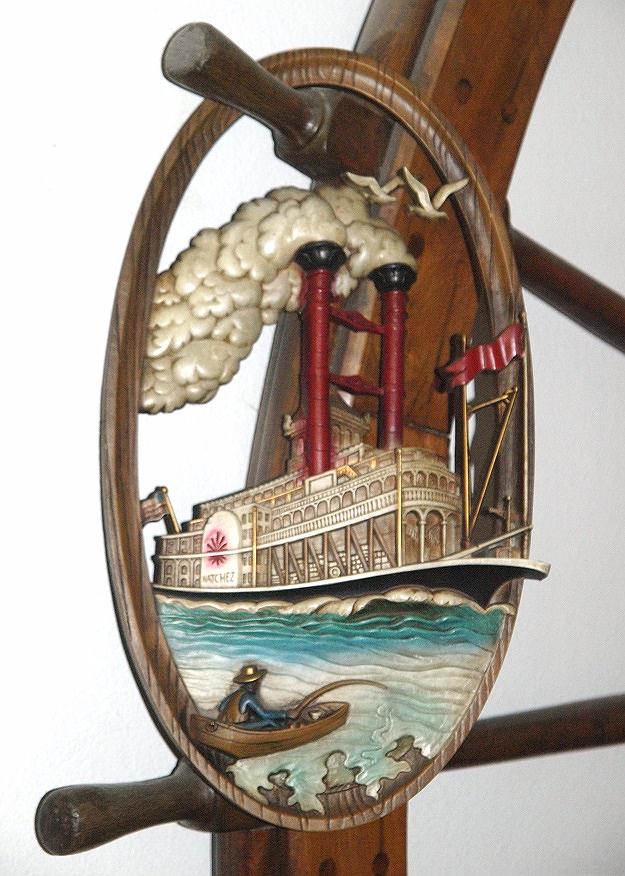
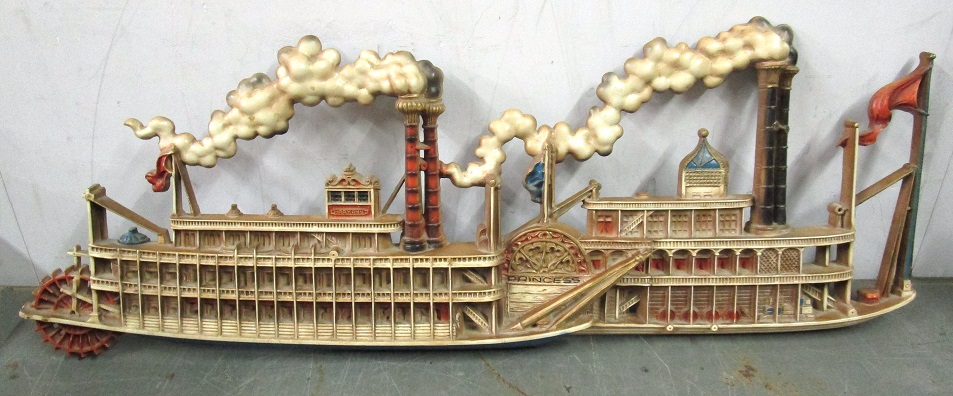
Steamboat NATCHEZ in oval frame cast in plastic and painted ALSO the MARY ANNE and the PRINCESS
Steamboat NATCHEZ by Burwood in oval frame cast in plastic and painted. A bit of 'kitsch' really but has some charm. Here it is slung over one of the handles on the 9 foot pilot wheel from the PEERLESS downstairs.
Manufactured by BURWOOD PRODUCTS
Number 1213 MCMLXXV (1975) - 11 x 19 3/4 inches
Burwood also made a 16 x 44 1/2 bas relief of sternwheeler Mary Ann and sidewheeler Princess which was listed on ETSY quite a while ago but I didn't buy it, attached a reduced photo from the listing. May buy one of these in the future if another one turns up on ETSY or on eBay.
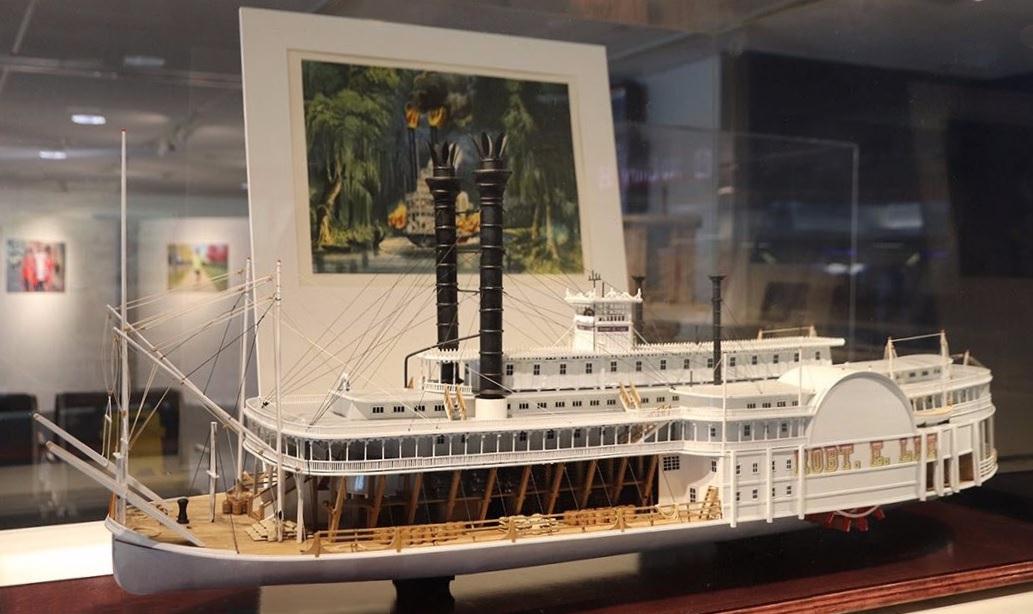
ROB'T E. LEE model in River and Rail Exhibit St. Louis Airport
Mississippi River Paddle Wheeler "Robert E. Lee" Model of the steamboat that was built in 1866 on exhibit at St. Louis Lambert Int'l Airport through May 12, 2020. Looks like it could be John Fryant's model from the Mud Island Museum in Memphis, Tennessee. The color lithograph above the model is 'Bayou by Torchlight' by Currier & Ives.
River and Rail Exhibit Highlights Early Days of St. Louis flystl.com
November 26, 2019
Art Media Releases
Two major elements that have long shaped St. Louis history are the focus of a new exhibition at St. Louis Lambert International Airport (STL). The St. Louis Mercantile Library at the University of Missouri St. Louis has opened its exhibition Travel by River and Rail in Early St. Louis at the Lambert Gallery, located on Terminal 1 Bag Claim Level, near exit 11.
The exhibition highlights the design of riverboats and railroads in the 19th and early 20th centuries through historic scale models, drawings, diagrams, and artwork, such as the work of Otto Kühler, a railroad designer and artist who created dynamic prints of train engines. There are also historic prints of river and rail travel, such as night scenes on the Mississippi River or the first train arriving in a frontier town by Currier & Ives. There are also models of steam engine trains, Pullman cars, flatboats, tugboats and paddle wheelers in the exhibition.
The exhibition pulled selections from its Pott Inland Waterways Library, the Barriger Railroad Library, and the Mercantile Library Art Museum to provide a broad insight into the world of travel, industry, architecture and art- which all had a significant impact on the early days of St. Louis.
Founded in 1846, and chartered by the State of Missouri in that year, the St. Louis Mercantile Library is the oldest general library in continuous existence west of the Mississippi River. The Mercantile Library continues to build its collections of rare books, manuscripts and artifacts that concentrate on Westward Expansion, American rail and river transportation history, the history of the St. Louis region, and particularly the works of Missouri and Midwestern artists. The Mercantile Library enhances its core educational mission through an active exhibition calendar both at the Library and through loans to museums around the country.
Recent Library exhibitions include 50 Great Women in the Arts (2011); Mapping St. Louis History (2014); and Angelo Corrubia: Scenes of St. Louis (2018).
Travel by River and Rail in Early St. Louis will be on display through May 12, 2020. The temporary exhibition is part of the Lambert Art & Culture Program, which is supported by the Regional Arts Commission. The St. Louis Mercantile Library was chosen to exhibit by the Airport's seven-member Airport Art Advisory Committee. Current members are Lisa Cakmak, Associate Curator of Ancient Art at Saint Louis Art Museum; Ellen Gale, Executive Director Clayton Chamber of Commerce; Shelley Hagen, Corporate Art Resources at Wells Fargo; Leslie Markle, Curator of Public Art, Mildred Lane Kemper Art Museum; Kiku Obata, Founding Principal of Kiku Obata & Co.; Roseann Weiss, consultant with ART+; and design artist and illustrator Carlos Zamora.
The Lambert Art and Culture Program builds upon the culturally rich legacy of St. Louis Lambert International Airport. The mission is to elevate the visitor experience and uplift regional pride through the presentation of artwork created by local, national, and international artists. Currently, there are nearly 30 works of art or collections of art (temporary, permanent or on-loan) on view at the Airport. For more information, visit artoftravelstl.com.
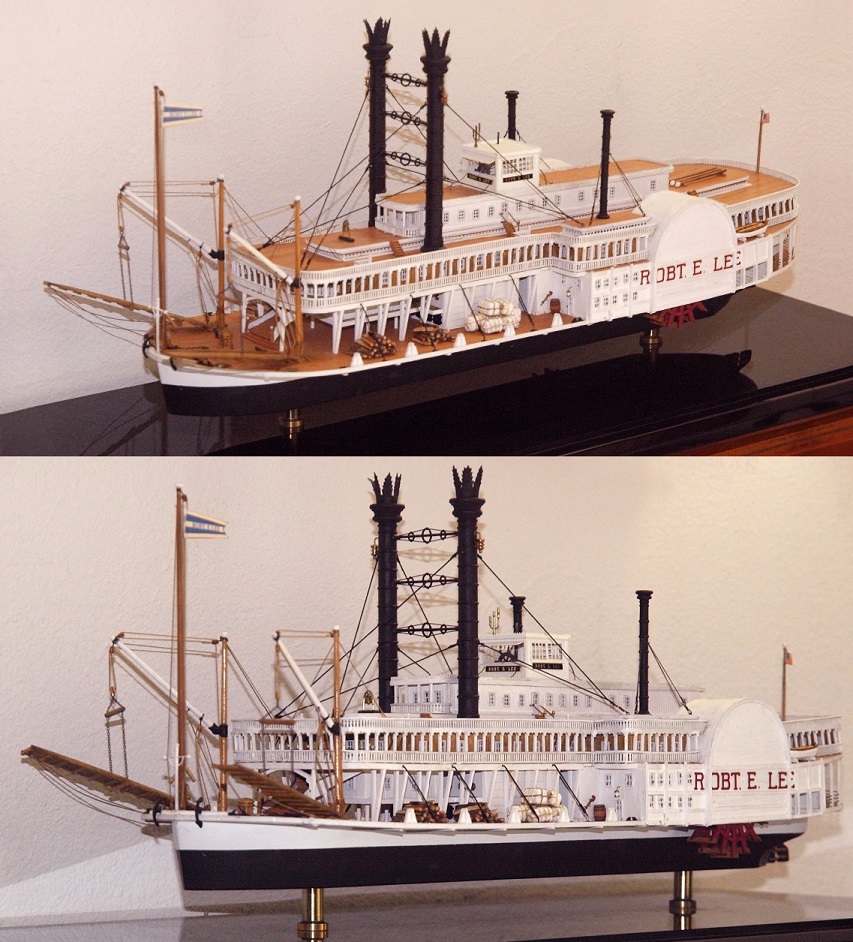
Two photos of the ROB'T E. LEE model from Dave Thomson's collection.
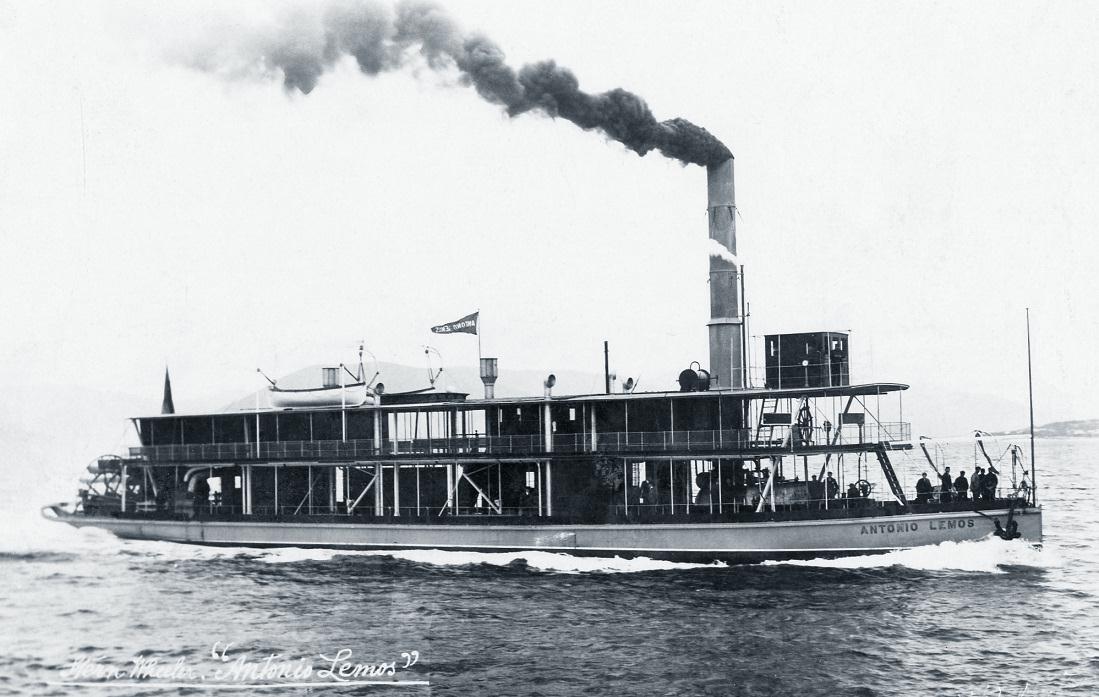
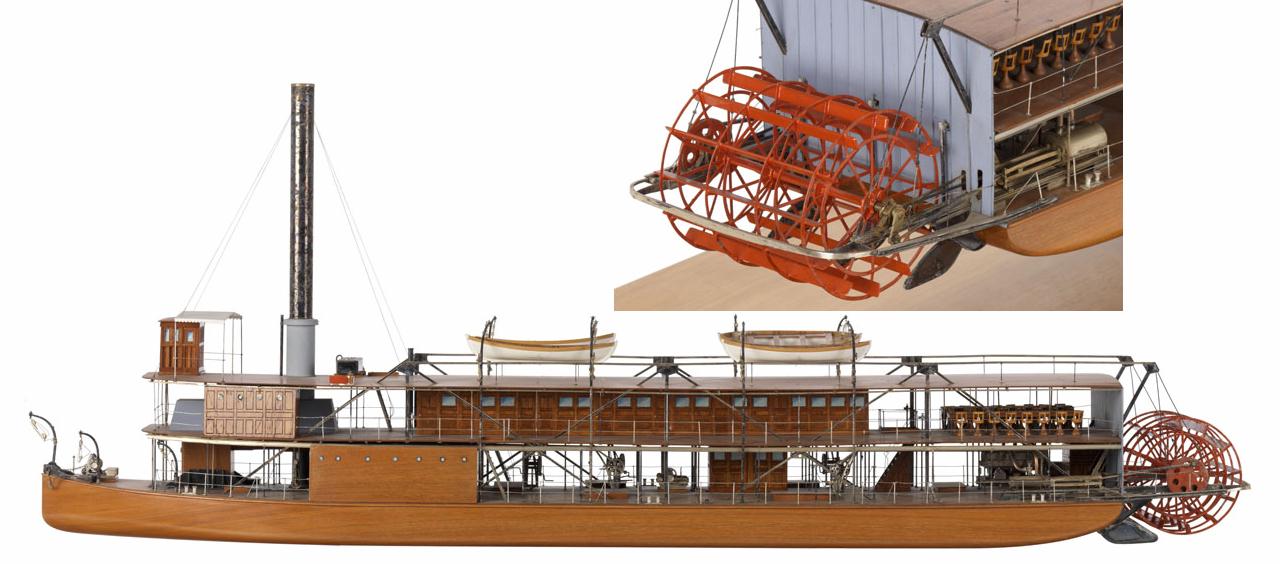
Photograph of the ANTONIO LEMOS circa 1900 and a model of the boat from the National Maritime Museum The differences between photos of the actual boat and the model are probably the result of remodeling done in Brazil after the boat arrived for service. Scale 1:48. A contemporary full hull model of the 'Antonio Lemos' (1900), a stern paddle steamer. Constructed in the builder's style, the model is decked and fully equipped and mounted on a modern baseboard. Built by Lobnitz & Company, Renfrew, it was designed by the Faversham firm of James Pollock & Sons and measured 171 feet in length by 30 feet in the beam with a tonnage of 300 gross. The 'Antonio Lemos' was powered by a non-condensing horizontal steam engine driving a stern paddle wheel at a top speed of 12 knots. A number of British shipyards specialized in the South American market and this stern paddle steamer is typical of a large number being produced to deal with the large volume of river trade, especially for Brazil, which was enjoying a boom in the rubber trade. This vessel was owned by the Amazon Steam Navigation Company, Para, and went out to Brazil under her own steam, sufficiently boarded up to protect against bad weather during the passage. She was eventually lost in Brazil in 1904.
National Maritime Museum, Greenwich, London
Read more at collections.rmg.co.uk
From the NATIONAL MARITIME MUSEUM collection
Greenwich, London, England
collections.rmg.co.uk

With the exception of images credited to public institutions,
everything on this page is from a private collection.
Please contact Steamboats.com for permission for commercial use.*
All captions provided by Dave Thomson, Steamboats.com primary contributor and historian.
